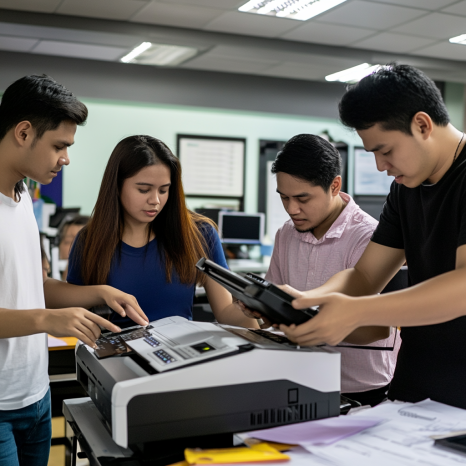
Innovations in Printer Maintenance
Part 1: The Evolution of Printer Maintenance: A Look at Innovations and Best Practices
Innovations in Printer Maintenance: Printer maintenance has come a long way from the days of frequent paper jams, smudged prints, and complicated repairs. In today’s digital age, innovations in printer technology and maintenance practices have revolutionized how businesses manage their printing needs. This evolution is particularly important for organizations that rely heavily on printers for day-to-day operations, as well as for those that utilize printer rentals for events. In this section, we’ll explore the key innovations in printer maintenance and how they are transforming the way businesses and event planners approach their printing solutions.
What is Printer Rental?
Printer rental is a convenient service that allows businesses to rent printers for a designated period, whether it’s just a few days or several months. This solution is ideal for event organizers who need access to high-quality printing equipment without committing to a long-term purchase. Whether you require a single unit for a small gathering or multiple printers for a large-scale conference, printer rentals offer the flexibility to adjust your printing capacity according to the specific needs of your event.
To begin your journey with printer rentals, our Introduction to Printer Rentals is a valuable resource for beginners. Understanding these basics will empower you to make informed decisions tailored to your business requirements.
For businesses focused on boosting productivity, the Best Printers for Office Use are designed to enhance operational efficiency and streamline workflow. To manage your budget effectively, check out our comprehensive guide on the Cost of Printer Rentals, where you’ll also find practical cost-saving tips.
When it comes to deciding between leasing and buying, our Printer Rentals vs. Purchasing analysis will help you choose the option that best fits your business objectives. Additionally, to explore the wide array of available options, visit our guide on the Types of Printers for Rent, specifically designed to meet various business demands.
For a thorough understanding of the flexibility and terms offered by our Printer Rental Contracts, visit our website. This information will guide you in selecting the most suitable rental agreement for your business, whether you’re considering Short-term or Long-term Rentals.
Finally, to ensure seamless operations at your event, consider our Printer Maintenance and Support services. Discover the best Printer Rental for Events today and elevate your event experience with reliable, high-quality printing solutions.
The Shift Towards Preventative Maintenance
One of the most significant changes in printer maintenance is the shift from reactive to preventative maintenance. In the past, printer maintenance was often carried out only when a problem occurred, leading to downtime, costly repairs, and potential disruptions to business operations. However, advancements in technology have enabled a more proactive approach, where potential issues are identified and addressed before they escalate into major problems.
Preventative maintenance involves regular inspections, software updates, and the replacement of parts that are nearing the end of their lifespan. This approach not only reduces the likelihood of unexpected breakdowns but also extends the lifespan of the printer, ultimately leading to cost-saving tips for businesses.
Smart Diagnostics: Modern printers are equipped with smart diagnostics that can monitor the condition of the machine in real-time. These systems can detect issues such as low toner levels, worn-out components, and potential paper jams before they occur. This allows businesses to schedule maintenance at convenient times, reducing downtime and ensuring that printers are always in optimal working condition.
Remote Monitoring and Maintenance
Another innovation that has transformed printer maintenance is the advent of remote monitoring and maintenance. This technology allows service providers to monitor the status of printers from a remote location, enabling them to perform diagnostics, troubleshoot issues, and even carry out repairs without the need for an on-site visit.
Remote Troubleshooting: In the past, when a printer malfunctioned, a technician would have to be dispatched to the location to diagnose and fix the problem. With remote monitoring, many issues can be resolved quickly and efficiently from a distance. For example, if a printer is experiencing connectivity issues or software errors, a technician can access the printer remotely to make the necessary adjustments, minimizing disruption to business operations.
Predictive Maintenance: Remote monitoring also enables predictive maintenance, where data collected from the printer is analyzed to predict when maintenance will be needed. This allows businesses to plan ahead and avoid unexpected downtime. Predictive maintenance is particularly valuable for organizations that rely on leasing printers, as it ensures that the equipment remains in top condition throughout the lease period.
The Role of Software in Modern Printer Maintenance
Software has become an integral part of modern printer maintenance, offering tools that help businesses manage their printing infrastructure more effectively. These software solutions range from basic utilities that monitor printer status to comprehensive management platforms that provide insights into usage patterns, maintenance needs, and maintenance costs.
Printer Management Software: Printer management software allows businesses to oversee multiple printers from a single interface. This software provides real-time data on printer usage, supply levels, and maintenance needs. It also offers tools for automating routine tasks, such as ordering new supplies when levels run low or scheduling regular maintenance checks. By using printer management software, businesses can optimize their printing operations, reduce costs, and ensure that their printers are always in good working order.
Automated Maintenance Schedules: Some printer management software solutions offer automated maintenance schedules, where the system automatically schedules maintenance based on usage patterns and diagnostics data. This ensures that maintenance is carried out at the right time, minimizing disruptions and keeping printers in optimal condition.
Printer Maintenance and Environmental Impact
In addition to improving efficiency and reducing costs, innovations in printer maintenance are also helping businesses reduce their environmental impact. As more organizations prioritize sustainability, the ability to maintain printers in an eco-friendly way has become increasingly important.
Sustainable Printers and Consumables: Modern printers are designed to be more energy-efficient and to use consumables that have a lower environmental impact. For example, many printers now offer duplex printing (printing on both sides of the paper) as a default setting, reducing paper usage. Additionally, toner cartridges are being designed with recycling in mind, making it easier for businesses to dispose of used cartridges responsibly. Choosing sustainable printers and eco-friendly maintenance practices can help organizations meet their sustainability goals.
Waste Reduction: Innovations in printer maintenance also contribute to waste reduction. Preventative and predictive maintenance reduce the need for emergency repairs and part replacements, leading to less waste generated by broken or obsolete components. Additionally, remote diagnostics and repairs reduce the carbon footprint associated with sending technicians to different locations, further contributing to environmental sustainability.
FAQs
What is the difference between reactive and preventative printer maintenance?
- Reactive maintenance is performed after a problem occurs, often leading to downtime and higher costs. Preventative maintenance, on the other hand, involves regular checks and maintenance to prevent issues before they arise, ensuring consistent printer performance and reducing overall maintenance costs.
How does remote monitoring benefit printer maintenance?
- Remote monitoring allows service providers to track the status of printers in real-time, enabling quick diagnostics and repairs without the need for an on-site visit. This reduces downtime, improves efficiency, and ensures that printers are always in optimal working condition.
What role does software play in modern printer maintenance?
- Software is essential for managing printer maintenance effectively. It provides real-time data on printer usage, automates maintenance schedules, and helps businesses monitor multiple printers from a single interface. This leads to optimized operations and reduced maintenance costs.
How can printer maintenance practices contribute to sustainability?
- By using energy-efficient printers, reducing waste through predictive maintenance, and opting for eco-friendly consumables, businesses can significantly reduce their environmental impact. These practices help organizations meet their sustainability goals while maintaining high operational efficiency.
What are the benefits of using printer management software?
- Printer management software offers several benefits, including real-time monitoring, automated maintenance schedules, and insights into usage patterns. These features help businesses reduce costs, improve efficiency, and ensure that their printers are always in good working order.

Part 2: Advanced Troubleshooting Techniques and Their Role in Printer Maintenance
As printers become more sophisticated, so too have the troubleshooting techniques used to maintain them. Advanced troubleshooting is no longer just about fixing a paper jam or replacing a toner cartridge; it now involves diagnosing complex software issues, optimizing network connections, and ensuring that printers operate efficiently in various environments. This section delves into the latest troubleshooting techniques that are transforming printer maintenance and helping businesses avoid costly downtime.
The Evolution of Printer Troubleshooting
Printer troubleshooting has evolved from manual processes to highly automated systems that can diagnose and fix problems with minimal human intervention. This evolution has been driven by the increasing complexity of printers, which now include advanced software, multiple connectivity options, and sophisticated user interfaces.
Automated Diagnostics: Modern printers come equipped with built-in diagnostics tools that can automatically detect and troubleshoot common issues. These tools can identify problems such as low ink levels, connectivity issues, and paper feed problems, and they often provide step-by-step instructions to resolve the issue. This automation reduces the need for technical expertise, allowing even non-technical users to troubleshoot and fix problems quickly.
Network Connectivity Issues: As more businesses rely on networked printers, troubleshooting network connectivity issues has become a crucial aspect of printer maintenance. Advanced troubleshooting techniques now include tools that can diagnose and fix network-related problems, such as IP conflicts, firewall settings, and driver issues. These tools ensure that printers remain accessible to all users on the network, minimizing disruption to business operations.
Software and Firmware Updates: Keeping printers up to date with the latest software and firmware is essential for maintaining performance and security. Advanced troubleshooting now includes automated checks for updates, ensuring that printers always run the latest versions. These updates often include bug fixes, performance improvements, and new features that enhance the printer’s capabilities.
The Role of Predictive Maintenance in Troubleshooting
Predictive maintenance has become a game-changer in printer maintenance, allowing businesses to anticipate and address potential issues before they lead to failures. By analyzing data collected from the printer, predictive maintenance can identify patterns and predict when a component is likely to fail. This proactive approach reduces the need for emergency repairs and minimizes downtime.
Data Analysis for Predictive Maintenance: Predictive maintenance relies on the analysis of data collected from printers over time. This data includes usage patterns, error logs, and performance metrics, which are analyzed to identify trends that could indicate an impending failure. For example, if a printer’s fuser unit shows signs of wear, predictive maintenance can schedule a replacement before the unit fails, preventing a breakdown.
Integration with Management Software: Predictive maintenance is often integrated with printer management software, providing a comprehensive solution for monitoring and maintaining printers. This integration allows businesses to automate maintenance tasks, receive alerts when issues are detected, and generate reports on the overall health of their printing infrastructure. By leveraging predictive maintenance, businesses can reduce maintenance costs and extend the lifespan of their printers.
The Importance of Regular Maintenance and Its Impact on Printer Performance
Regular maintenance is essential for ensuring that printers operate efficiently and reliably. While advanced troubleshooting techniques can resolve many issues, regular maintenance helps prevent these issues from occurring in the first place. By following a consistent maintenance schedule, businesses can keep their printers in top condition and avoid the disruptions caused by unexpected breakdowns.
Cleaning and Calibration: One of the most basic yet important aspects of printer maintenance is regular cleaning and calibration. Dust, debris, and ink residue can accumulate inside the printer over time, leading to poor print quality and mechanical issues. Regular cleaning removes these contaminants, while calibration ensures that the printer’s components are aligned and functioning correctly.
Replacing Consumables: Consumables such as toner cartridges, ink cartridges, and paper need to be replaced regularly to maintain print quality and prevent damage to the printer. Advanced troubleshooting techniques often include monitoring the levels of these consumables and providing alerts when they need to be replaced. By keeping consumables well-stocked, businesses can avoid the disruptions caused by running out of supplies during critical print jobs.
Checking for Wear and Tear: Over time, the components of a printer can wear out, leading to mechanical failures and reduced performance. Regular maintenance includes checking for signs of wear and tear, such as worn rollers, belts, and fuser units. By replacing these components before they fail, businesses can avoid costly repairs and extend the life of their printers.
Contractual Considerations for Printer Maintenance
When it comes to printer maintenance, the terms of your printer rental contracts or leasing agreements play a significant role in determining the level of service you receive. It’s important to understand what is included in your contract and to negotiate terms that meet your business’s needs.
Service Level Agreements (SLAs): Many printer rental contracts include Service Level Agreements (SLAs) that define the level of maintenance and support provided by the rental company. These agreements typically cover response times for repairs, the availability of replacement parts, and the conditions under which a technician will be dispatched. Understanding your SLA is crucial for ensuring that your printers are maintained according to your business’s needs.
Maintenance Costs and Inclusions: The cost of maintenance is another important consideration when renting or leasing printers. Some contracts include maintenance as part of the rental fee, while others may charge extra for certain services. Be sure to review the maintenance costs included in your contract and understand what is covered.
Flexibility in Contracts: Printer maintenance needs can change over time, so it’s important to have flexibility in your rental or leasing contract. Look for contracts that allow you to adjust the level of maintenance as needed, whether that means increasing the frequency of service visits or upgrading to a more comprehensive maintenance plan. Contracts that offer flexibility ensure that your printers are always maintained according to your evolving business needs.
Expanded FAQs
What are the benefits of predictive maintenance for printers?
- Predictive maintenance allows businesses to anticipate and address potential issues before they lead to printer failures. By analyzing data from the printer, predictive maintenance can identify trends that suggest an impending failure, allowing for proactive repairs and minimizing downtime.
How does automated troubleshooting improve printer maintenance?
- Automated troubleshooting tools built into modern printers can detect and resolve common issues without the need for technical expertise. These tools can identify problems like low ink levels, connectivity issues, and paper feed problems, and provide step-by-step instructions for resolution.
Why is regular maintenance important for printers?
- Regular maintenance helps prevent issues from occurring in the first place, ensuring that printers operate efficiently and reliably. Maintenance tasks like cleaning, calibration, and replacing consumables are essential for maintaining print quality and extending the lifespan of the printer.
What should I look for in a printer maintenance contract?
- When reviewing a printer maintenance contract, look for terms that include Service Level Agreements (SLAs), coverage of maintenance costs, and flexibility to adjust the level of service as needed. Understanding these terms ensures that your printers are maintained according to your business’s needs.
How can I reduce maintenance costs for printers?
- Maintenance costs can be reduced by adopting predictive maintenance practices, using printer management software to automate routine tasks, and choosing a maintenance plan that aligns with your business’s usage patterns. Regular maintenance and timely replacement of consumables also help prevent costly repairs.

Part 3: Legal Considerations and Future Trends in Printer Maintenance
As businesses increasingly rely on printers for day-to-day operations, understanding the legal implications and staying ahead of future trends in printer maintenance is crucial. This final section will explore the legal aspects that businesses must consider when engaging in printer maintenance, as well as the emerging trends that are likely to shape the future of printer maintenance practices.
Legal Considerations in Printer Maintenance
Printer maintenance, particularly in the context of rental and leasing agreements, involves several legal considerations that businesses need to be aware of. These considerations ensure that businesses comply with relevant regulations and protect themselves from potential liabilities.
Contractual Obligations: One of the most important legal aspects of printer maintenance is understanding the contractual obligations outlined in printer rental contracts. These contracts typically specify the responsibilities of both the rental provider and the lessee, including maintenance schedules, service level agreements, and the handling of repairs and replacements. Businesses must carefully review these contracts to ensure they understand their obligations and rights.
Liability for Damages: Another key legal consideration is liability for damages. If a printer is damaged while under a rental or leasing agreement, the contract will usually outline who is responsible for the repair costs. It’s essential to clarify these terms before signing the contract to avoid unexpected expenses. Some contracts may include insurance options that cover damage, while others may require the lessee to pay for repairs out of pocket.
Compliance with Environmental Regulations: As more businesses focus on sustainability, compliance with environmental regulations has become a significant concern in printer maintenance. This includes the proper disposal of consumables such as toner cartridges and the recycling of printer components. Businesses should ensure that their maintenance practices comply with local and national environmental regulations to avoid fines and contribute to sustainable practices. Understanding the environmental impact of printer maintenance is critical for aligning with corporate social responsibility goals.
Data Security and Privacy: Modern printers often store sensitive data, such as print logs and scanned documents, which can pose security risks if not properly managed. Legal considerations around data security and privacy are becoming increasingly important in printer maintenance. Businesses must ensure that any maintenance or repair work conducted on their printers does not compromise the security of their data. This may involve working with service providers who adhere to strict data protection protocols.
Future Trends in Printer Maintenance
The field of printer maintenance is continuously evolving, with new technologies and practices emerging that promise to further enhance efficiency, reduce costs, and improve sustainability. Staying ahead of these trends can help businesses optimize their printer maintenance strategies and remain competitive.
IoT Integration: The Internet of Things (IoT) is making its way into printer maintenance, enabling even greater connectivity and automation. IoT-enabled printers can communicate with other devices and systems, allowing for real-time monitoring, remote diagnostics, and automated supply ordering. This level of integration reduces the need for manual intervention and ensures that printers are always ready to perform.
AI-Driven Maintenance: Artificial Intelligence (AI) is poised to revolutionize printer maintenance by enabling more advanced predictive maintenance capabilities. AI-driven systems can analyze vast amounts of data to predict not only when a component is likely to fail but also the best time to perform maintenance based on usage patterns. This proactive approach minimizes downtime and extends the lifespan of the printer, leading to significant cost savings.
Sustainability and Green Maintenance Practices: As businesses continue to prioritize sustainability, green maintenance practices are becoming more prevalent. This includes using eco-friendly printers, recycling consumables, and reducing energy consumption through efficient maintenance practices. Businesses that adopt these practices not only contribute to environmental conservation but also enhance their brand reputation as responsible corporate citizens.
Subscription-Based Maintenance Models: The shift towards subscription-based models in printer maintenance is gaining traction. Under these models, businesses pay a regular fee that covers all maintenance and repair services, including parts and labor. This approach provides predictable costs and eliminates the need for large, unexpected expenses. It also ensures that printers are maintained regularly, reducing the likelihood of breakdowns and extending the equipment’s lifespan.
Customization and Personalization: As technology advances, the ability to customize and personalize printer maintenance services will become more widespread. Businesses will be able to tailor maintenance plans to their specific needs, choosing the level of service, the frequency of maintenance visits, and the types of consumables used. This flexibility allows businesses to optimize their maintenance strategies based on their unique requirements and usage patterns.
Increased Focus on Data Security: With the growing concern over data security, future printer maintenance practices will place a greater emphasis on protecting sensitive information. This may involve enhanced encryption of data stored on printers, secure disposal of old components, and stringent protocols for accessing and handling data during maintenance.
FAQs
What are the key legal considerations when maintaining rented or leased printers?
- Key legal considerations include understanding the contractual obligations outlined in printer rental contracts, clarifying liability for damages, ensuring compliance with environmental regulations, and protecting data security during maintenance.
How does IoT integration benefit printer maintenance?
- IoT integration allows printers to communicate with other devices and systems, enabling real-time monitoring, remote diagnostics, and automated supply ordering. This reduces the need for manual intervention and ensures that printers are always ready to perform, minimizing downtime and improving efficiency.
What role will AI play in the future of printer maintenance?
- AI will enable more advanced predictive maintenance capabilities by analyzing large amounts of data to predict when components are likely to fail and determine the best time to perform maintenance. This proactive approach reduces downtime, extends printer lifespan, and leads to significant cost savings.
How can businesses ensure their printer maintenance practices are environmentally sustainable?
- Businesses can adopt green maintenance practices by using eco-friendly printers, recycling consumables, reducing energy consumption, and working with service providers who prioritize sustainability. These practices contribute to environmental conservation and enhance brand reputation.
What are the benefits of subscription-based maintenance models for printers?
- Subscription-based maintenance models provide predictable costs by covering all maintenance and repair services for a regular fee. This approach eliminates large, unexpected expenses and ensures that printers are maintained regularly, reducing the likelihood of breakdowns and extending the equipment’s lifespan.
How can businesses protect data security during printer maintenance?
- To protect data security, businesses should work with service providers who adhere to strict data protection protocols, such as encrypting data stored on printers and ensuring secure disposal of old components. Regular audits and clear guidelines for handling sensitive information during maintenance are also crucial.
What is the importance of flexibility in printer maintenance contracts?
- Flexibility in printer maintenance contracts allows businesses to adjust the level of service as their needs evolve. This includes the ability to increase the frequency of maintenance visits, upgrade to more comprehensive maintenance plans, or adjust service levels based on changing usage patterns.
How do subscription-based maintenance models compare to traditional maintenance plans?
- Subscription-based maintenance models offer more predictable costs and continuous service coverage, reducing the risk of unexpected expenses. Traditional maintenance plans may involve higher upfront costs and variable expenses, depending on the frequency and complexity of required maintenance.
What should businesses consider when negotiating printer maintenance contracts?
- When negotiating printer maintenance contracts, businesses should consider the scope of services included, response times for repairs, the flexibility to adjust service levels, and the total cost of the contract. Ensuring that the contract aligns with the business’s operational needs and budget is crucial.
How will future trends in printer maintenance impact businesses?
- Future trends such as IoT integration, AI-driven maintenance, and subscription-based models will enhance efficiency, reduce costs, and improve sustainability in printer maintenance. Businesses that stay ahead of these trends will be better positioned to optimize their printing infrastructure and maintain a competitive edge.

To learn more about sustainable copier rental solutions and how Marga Enterprises can support your green initiatives, contact us today at 09171642540 or 09614481276. You can also reach us via email at marga.enterprises2013@gmail.com. Let’s work together to build a greener, more sustainable future for generations to come. Visit Marga Enterprises and find out why we are the No. 1 Copier & Printer Rental Provider in the Philippines.
Join our growing community on Facebook and Youtube for exclusive content and discussions designed to propel your business forward. Follow our posts and be part of the conversation!
